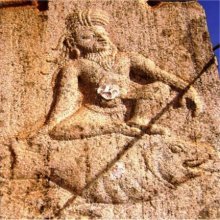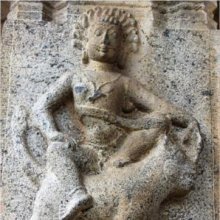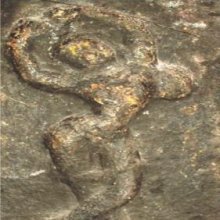Yogapatta, Yogapaṭṭa, Yoga-patta: 12 definitions
Introduction:
Yogapatta means something in Hinduism, Sanskrit, Jainism, Prakrit, the history of ancient India. If you want to know the exact meaning, history, etymology or English translation of this term then check out the descriptions on this page. Add your comment or reference to a book if you want to contribute to this summary article.
Images (photo gallery)
(+14 more images available)
In Hinduism
Kavya (poetry)
Source: archive.org: Naisadhacarita of SriharsaYogapaṭṭa (योगपट्ट) refers to a “cloth worn during meditation”, and is mentioned in the Naiṣadha-carita 2.78.—(“śritavaprāvaliyogapaṭṭayā”). The word [yogapaṭṭa] occurs also in 11.18. It is used in Kādambarī (Pūrvabhāga). Cf. Sūtasaṃhitā (Jñānayogakhaṇḍa 6.9), in connection with the custom of religious mendicants.

Kavya (काव्य, kavya) refers to Sanskrit poetry, a popular ancient Indian tradition of literature. There have been many Sanskrit poets over the ages, hailing from ancient India and beyond. This topic includes mahakavya, or ‘epic poetry’ and natya, or ‘dramatic poetry’.
Purana and Itihasa (epic history)
Source: archive.org: Shiva Purana - English TranslationYogapaṭṭa (योगपट्ट) refers to “(one seated in) the Yogic posture”, according to the Śivapurāṇa 2.3.23 (“Attempt of Himavat to dissuade Pārvatī”).—Accordingly, after Viṣṇu spoke to the Gods and others: “[...] O sage, you came back again and beckoning to the gods, with effort you took them, Viṣṇu and others, to Him. Then Viṣṇu and other gods went there and saw lord Śiva, favourably disposed to His devotees, delighted and comfortably seated. Then Viṣṇu, the gods, the Siddhas, the sages and I bowed to and eulogised Śiva seated in the Yogic posture [i.e., yogapaṭṭa-sthita], surrounded by the Gaṇas. He was seated in the form. of penance. We eulogised Him with hymns from the Vedas and Upaniṣads”.

The Purana (पुराण, purāṇas) refers to Sanskrit literature preserving ancient India’s vast cultural history, including historical legends, religious ceremonies, various arts and sciences. The eighteen mahapuranas total over 400,000 shlokas (metrical couplets) and date to at least several centuries BCE.
Shaivism (Shaiva philosophy)
Source: SOAS University of London: Protective Rites in the Netra TantraYogapaṭṭa (योगपट्ट) refers to a “Yoga strap”, according to the Netratantra of Kṣemarāja: a Śaiva text from the 9th century in which Śiva (Bhairava) teaches Pārvatī topics such as metaphysics, cosmology, and soteriology.—Accordingly, [verse 18.63-68, while describing the iconography of Mṛtyujit and the consort Amṛtalakṣmī]—“After [the Mantrin] has meditated on the beautiful form as indicated earlier, he should worship Mṛtyujit and Śrī Devī [Amṛtalakṣmī], [...]. She is charming [and] wears a pure white crown. [She has] one face, three eyes, [and is] seated in the baddhapadmāsana, adorned with a Yoga strap (yogapaṭṭa), a conch and lotus in [her] hand, the hands [forming the gestures of] wish-granting and protection. Four armed, Mahādevī is marked with all auspicious signs. [...]”.

Shaiva (शैव, śaiva) or Shaivism (śaivism) represents a tradition of Hinduism worshiping Shiva as the supreme being. Closely related to Shaktism, Shaiva literature includes a range of scriptures, including Tantras, while the root of this tradition may be traced back to the ancient Vedas.
In Jainism
General definition (in Jainism)
Source: archive.org: TrisastisalakapurusacaritraYogapaṭṭa (योगपट्ट) or Yogapaṭa is the secret traditional knowledge handed down orally by a guru to a disciple as his successor.

Jainism is an Indian religion of Dharma whose doctrine revolves around harmlessness (ahimsa) towards every living being. The two major branches (Digambara and Svetambara) of Jainism stimulate self-control (or, shramana, ‘self-reliance’) and spiritual development through a path of peace for the soul to progess to the ultimate goal.
India history and geography
Source: Cologne Digital Sanskrit Dictionaries: Indian Epigraphical GlossaryYoga-paṭṭa.—(EI 14), band used by the ascetics to keep their limbs in a position of rigidity. Note: yoga-paṭṭa is defined in the “Indian epigraphical glossary” as it can be found on ancient inscriptions commonly written in Sanskrit, Prakrit or Dravidian languages.

The history of India traces the identification of countries, villages, towns and other regions of India, as well as mythology, zoology, royal dynasties, rulers, tribes, local festivities and traditions and regional languages. Ancient India enjoyed religious freedom and encourages the path of Dharma, a concept common to Buddhism, Hinduism, and Jainism.
Languages of India and abroad
Sanskrit dictionary
Source: DDSA: The practical Sanskrit-English dictionaryYogapaṭṭa (योगपट्ट).—a cloth thrown over the back and knees of an ascetic during abstract meditation; क्षणनीरवया यया निशि श्रितवप्रावलियोगपट्टया (kṣaṇanīravayā yayā niśi śritavaprāvaliyogapaṭṭayā) N.2.78; एकान्तावलम्बितयोगपट्टिकाम् गुहाम् (ekāntāvalambitayogapaṭṭikām guhām) K. Pūrvabhāga.
Derivable forms: yogapaṭṭam (योगपट्टम्).
Yogapaṭṭa is a Sanskrit compound consisting of the terms yoga and paṭṭa (पट्ट).
Source: Cologne Digital Sanskrit Dictionaries: Shabda-Sagara Sanskrit-English DictionaryYogapaṭṭa (योगपट्ट).—m.
(-ṭṭaḥ) A cloth drawn round the lower extremities of the ascetic as he spuats to perform religious abstraction. E. yoga a religious exercise, paṭṭa cloth.
Source: Cologne Digital Sanskrit Dictionaries: Monier-Williams Sanskrit-English DictionaryYogapaṭṭa (योगपट्ट):—[=yoga-paṭṭa] [from yoga] ([Hemādri’s Caturvarga-cintāmaṇi; Padma-purāṇa]) ([Harṣacarita; Padma-purāṇa]) m. the cloth thrown over the back and knees of a devotee during meditation.
Source: Cologne Digital Sanskrit Dictionaries: Yates Sanskrit-English DictionaryYogapaṭṭa (योगपट्ट):—[yoga-paṭṭa] (ṭṭaḥ) 1. m. Cloth of a Yogī.
[Sanskrit to German]
Sanskrit, also spelled संस्कृतम् (saṃskṛtam), is an ancient language of India commonly seen as the grandmother of the Indo-European language family (even English!). Closely allied with Prakrit and Pali, Sanskrit is more exhaustive in both grammar and terms and has the most extensive collection of literature in the world, greatly surpassing its sister-languages Greek and Latin.
Kannada-English dictionary
Source: Alar: Kannada-English corpusYōgapaṭṭa (ಯೋಗಪಟ್ಟ):—[noun] = ಯೋಗಪಟ [yogapata].
Kannada is a Dravidian language (as opposed to the Indo-European language family) mainly spoken in the southwestern region of India.
See also (Relevant definitions)
Starts with: Yoga-pattaka, Yogapattasana.
Full-text: Yogakaksha, Yogasana, Yoga-pattaka, Sanaka, Sanandana, Sanat, Sanatkumara, Yogapattasana, Trimurti, Yogeshvara.
Relevant text
Search found 11 books and stories containing Yogapatta, Yogapaṭṭa, Yoga-patta, Yoga-paṭṭa, Yōgapaṭṭa, Yōga-paṭṭa; (plurals include: Yogapattas, Yogapaṭṭas, pattas, paṭṭas, Yōgapaṭṭas). You can also click to the full overview containing English textual excerpts. Below are direct links for the most relevant articles:
Chaitanya Bhagavata (by Bhumipati Dāsa)
Verse 1.10.12 < [Chapter 10 - Marriage with Śrī Lakṣmīpriyā]
Verse 2.1.287 < [Chapter 1 - The Beginning of the Lord’s Manifestation and His Instructions on Kṛṣṇa-saṅkīrtana]
Verse 1.13.66 < [Chapter 13 - Defeating Digvijayī]
Middle Chola Temples (by S. R. Balasubrahmanyam)
Temples in Vikkanampundi < [Vijayalaya]
Temples in Tiruvalisvaram < [Chapter II - Temples of Rajaraja I’s Time]
Parivaralayattu Pillaiyar < [Tanjavur/Thanjavur (Rajarajesvaram temple)]
Amaravati Art in the Context of Andhra Archaeology (by Sreyashi Ray chowdhuri)
Mahilāmukha Jātaka < [Chapter 3 - Amarāvatī and the Formative Stage of the Buddhist Art]
The Padma Purana (by N.A. Deshpande)
Chapter 123 - Instructions Concerning the Fast < [Section 6 - Uttara-Khaṇḍa (Concluding Section)]
Chapter 119 - In Praise of a Fast for a Month < [Section 6 - Uttara-Khaṇḍa (Concluding Section)]
Chapter 34 - The gift of Brahmāṇḍa < [Section 1 - Sṛṣṭi-khaṇḍa (section on creation)]
The Brahmanda Purana (by G.V. Tagare)
Chapter 21 - The Dialogue between Aurva and Paraśurāma < [Section 3 - Upodghāta-pāda]
The Shiva Purana (by J. L. Shastri)
Chapter 18 - The procedure of initiating a disciple < [Section 6 - Kailāsa-saṃhitā]
Chapter 19 - The rules of Yogapaṭṭa < [Section 6 - Kailāsa-saṃhitā]
Related products






